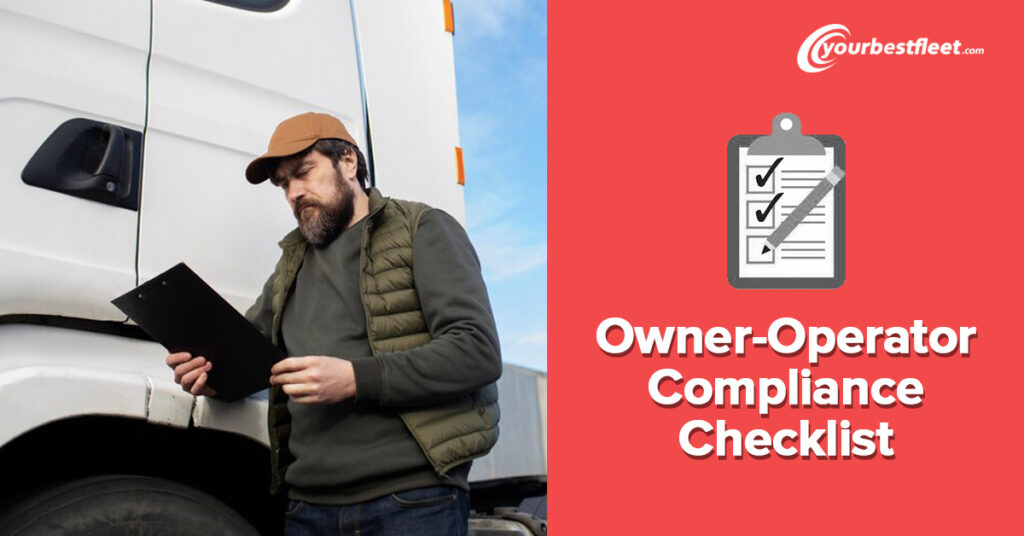Whether in a startup or an established business, fleet owner-operators must adhere to government regulations. The Department of Transportation (DOT) has established rules, guidelines, and procedures that fleet businesses must follow to ensure the safety of all drivers. Audits can occur anytime, so you should always be prepared with your compliance records and updates. In 2022, over 59,000 vehicles were inspected in 72 hours.
This article provides a comprehensive overview of the trucking company compliance checklist. It aims to help you understand some key points for keeping your company operating within regulatory standards. This extensive list of compliance requirements will guide your company in preparing for any audit by organizing and maintaining all necessary systems.
Compliance Checklist for Owner-Operators
The compliance checklist is a vital instrument for owners and managers that helps them run their businesses quickly and adequately while making the most of important resources. It turns restrictions by regulations into chances for good things to happen. The key elements of the plan are discussed below:
Hours of Service (HOS)
The Federal Motor Carrier Safety Administration maintains a compliance checklist that mentions the Hours of Service regulations. The rule specifies the number of consecutive duty hours for drivers to minimize the chances of fatigue-related accidents. The key points of this rule are mentioned below.
- 11-hour window: Drivers are only permitted to drive for a maximum of 11 hours and must take 10 hours off duty in 24 hours.
- 14-hour period: Drivers must finish their 11 maximum driving hours within a 14-hour window.
- 30-minute intermission: After eight hours on duty, drivers must take a 30-minute rest break within the 14-hour driving window.
- Limits of 60 to 70 hours: Drivers may only operate a vehicle for 60 hours in seven days and 70 hours in eight days.
- 34-hour restart: Drivers can reset their 60- or 70-hour restrictions by taking 34 straight hours off duty after they have exceeded the duty-hour restrictions for seven or eight days.
Maintaining Updated Records
It is not enough to just follow the rules. Owner-Operators must demonstrate that you have followed them. You should have documentation containing the origin and destination of each journey for each 24 hours of duty. The following particulars need to be considered for record-keeping:
- Record the total number of hours (classified as driving, sleeping in a berth, being on duty, and off-duty).
- The origin and destination of each trip should be listed on the relevant document.
- Receipts with expenses paid are also helpful in demonstrating that the drivers took a break.
- The FMCSA mandates that records be kept for a minimum of six months.
Use of Electronic Logging Devices
According to the FMCSA, most motor carriers and drivers who must keep a record of duty status (RODS) must carry an electronic logging device (ELD). Owner-operators operating under their authority must determine if the ELD rule applies to them.
ELDs can assist you in keeping track of all information by automatically recording your driving time and location to promote safe working practices as per regulations. You must obtain an ELD from a source certified and registered with the FMCSA. The application of ELD encompasses the following:
- ELDs automatically record driving time, removing the possibility of human error in documentation.
- Fleet managers have access to real-time data, allowing for the management of HOS compliance.
- ELDs can generate alerts for impending HOS violations, allowing prompt action.
- Electronic Logging Devices (ELDs) streamline record-keeping by making it simpler and more efficient.
- ELD data provides useful inputs for improving schedules and routes to increase productivity.
- ELDs give drivers more control over their work schedules, which fosters a more accountable and secure work environment.
Maintenance Compliance
To comply with FMCSA rules, all owner-operators must regularly inspect their trucks to identify and address all technical issues. If you are pulled over for a roadside inspection, having completed records of inspections can help your firm ensure compliance. The different checkpoints related to this are mentioned below.
Pre-Trip Inspection
The pre-trip inspection is an important step for commercial vehicle compliance since it helps to discover and rectify problems that could become safety hazards during the trip. It entails inspecting essential vehicle components such as tires, brakes, lights, and mirrors for wear, damage, or malfunction.
Post-Trip Inspection
Post-trip inspections are required to detect any defects in the vehicle that may have formed while on the road. These inspections can avert serious flaws and delays by performing the necessary corrective procedures.
Keeping Records
Following the completion of the vehicle inspection, drivers must note the findings in the Driver Vehicle Inspection Report (DVIR) format. This report is critical for quick remedial action, preventing future malfunctions, and ensuring safety.
Reports Accessibility
The DVIR must be available to authorities, who will review it to ensure that all problems are suitably addressed through necessary repair and maintenance activities. DVIRs need to be maintained for six months.
Responsibility
Drivers play an important part in maintaining vehicle safety by doing these inspections and reporting any issues. The motor carrier must also confirm that all remedial actions have been implemented and that the vehicle can operate on public roads following the necessary repairs and maintenance.
International Fuel Tax Agreement (IFTA) Regulations
Fuel taxes go toward funding road maintenance. That is why states want to ensure they receive their fair share based on the miles driven. As an owner-operator, you must register your vehicle with the IFTA and submit a quarterly fuel tax return. The IFTA guidelines require meticulous attention to detail in reporting and record-keeping. Below is an explanation of the various parts of IFTA compliance:
- Meeting IFTA Requirements: Fleet managers are expected to report fuel use, distance driven, and mileage to promote equitable tax allocation among states and provinces.
- Automated Data Logging: Tracking and gathering data for IFTA reports requires complicated computations that automation can execute rapidly to ensure correct and timely reporting.
- Efficient reporting: Software can generate IFTA reports, which streamline the submission procedure and considerably lower administrative effort.
- Real-Time Tracking: Advanced fleet management systems aid in compliance by providing real-time data on fuel consumption and travel records.
- Staying Updated: To ensure continual compliance, fleet management software has to be constantly updated to accommodate IFTA requirements.
Drug And Alcohol Testing
The Department of Transportation (DOT) requires owner-operators to participate in a drug and alcohol testing program. The rule applies to interstate and intrastate commercial vehicle drivers, mechanics, warehouse workers, and other supporting staff. The following parameters substantially define the scope of this regulation:
- Testing Requirements: To reduce potential threats to individual and public safety, the FMCSA and DOT require drug and alcohol testing for drivers.
- Conditions: pre-employment, post-accident, upon return to duty, after a reasonable suspicion, and random testing, all can be carried out.
- Registration: Owners and operators must register with a consortium approved by the Department of Transportation, which manages the testing.
- Compliance guidelines: The testing procedures must meet DOT guidelines to assure validity and reliability.
- Tested Substance Types: Prohibited PCP, cocaine, opiates, amphetamines, and marijuana are examples of illegal substances.
- Alcohol Limits: The FMCSA sets a blood alcohol concentration limit of 0.04% for commercial drivers.
- Testing Methodologies: Certified labs adhering to strict protocols are recommended for testing performance.
- Record-keeping: Employers must meticulously document all testing-related activities.
- Confidentiality: The testing results are private and should be kept confidential.
Driver Qualification File (DQF)
The FMCSA requires owner-operators of trucking businesses to store a driver qualification file for each driver, with the following respective information for the past three years:
- The employee application must have complete information about the driver.
- Motor Vehicle Record (MVR) for every state where you held a business license or permit for the preceding three years
- MVR evaluations are to be done yearly with a record of any violations of FMCSA regulations.
- A copy of your commercial driver’s license (CDL)
- Medical Examiners Certificate is valid for up to 24 months.
- A note of confirmation that the medical examiner was on the National Registry of Certified Medical Examiners List
International Registration Plan (IRP)
The IRP is necessary for all vehicles that weigh more than 26,000 pounds and travel across state borders. The IRP requires paying license fees based on the number of jurisdictions your fleet visits. Enrolling in the IRP will help you reduce costs, depending on how many jurisdictions you drive through. If most of your trips are carried out within one jurisdiction, apportioning in that jurisdiction is most likely cost-effective.
Conclusion
The fleet businesses must adhere to all DOT safety guidelines and requirements to safeguard drivers and other vehicle users. A compliance checklist is an invaluable resource to ensure owner-operators comply with the many rules and regulations affecting their businesses. We have focused in this article on the importance of using this checklist as a reference for ensuring compliance with regulations and optimal productivity.
Common aspects of this compliance include vehicle upkeep, working hours, tax rules, and driver particulars. Compliance with this checklist helps owner-operators save money, decrease the possibility of accidents, maximize equipment utilization, and keep a good name in the business. Ultimately, this leads to a safer, more reliable, and compliant trucking operation.
James Johnson is a former truck driver who now works as a writer, specializing in the trucking industry. With over 15 years of experience on the road, James has a unique perspective on the challenges and opportunities faced by truck drivers and the trucking industry as a whole. His writing focuses on issues such as safety, regulation, and the latest industry trends. His work has been featured in several trucking publications and he has received recognition for his contributions to the industry. In his free time, James still enjoys being around trucks and often attends truck shows and other industry events.


